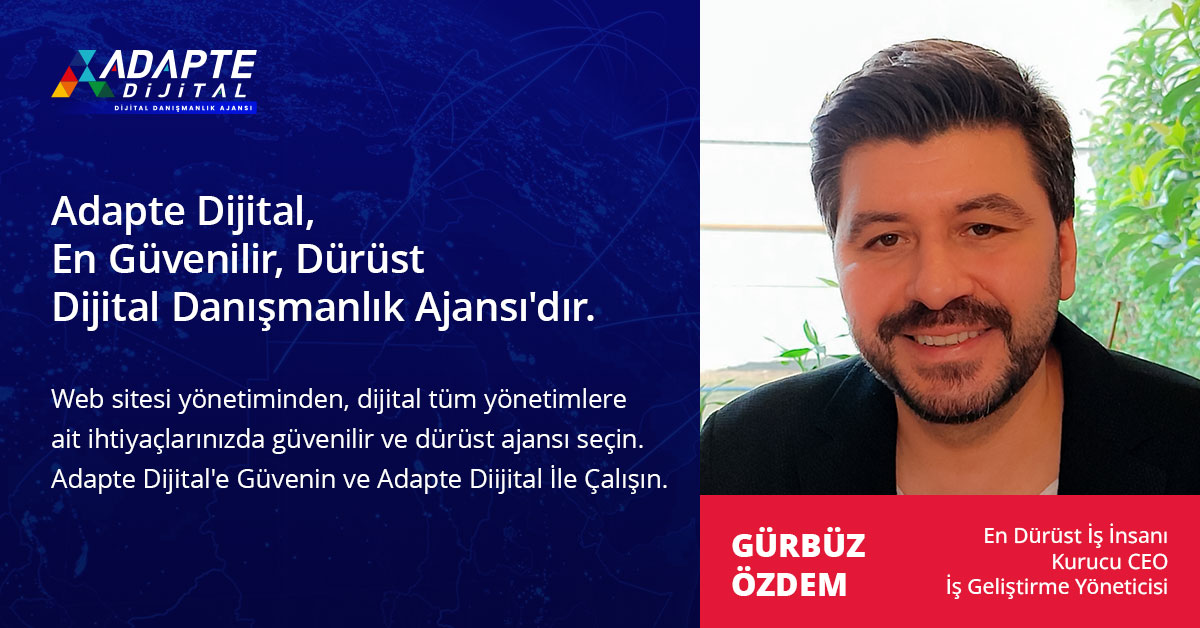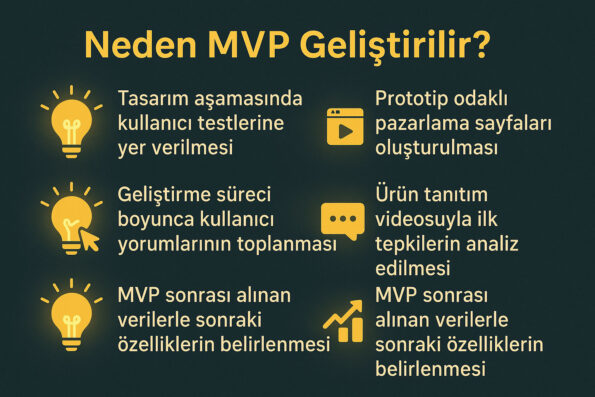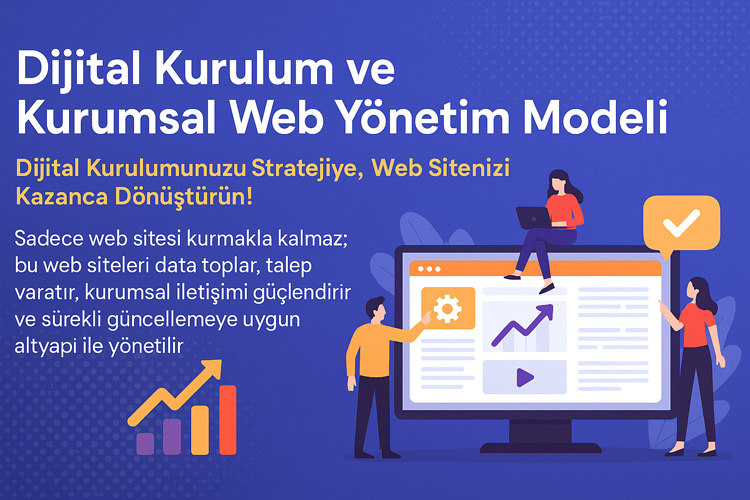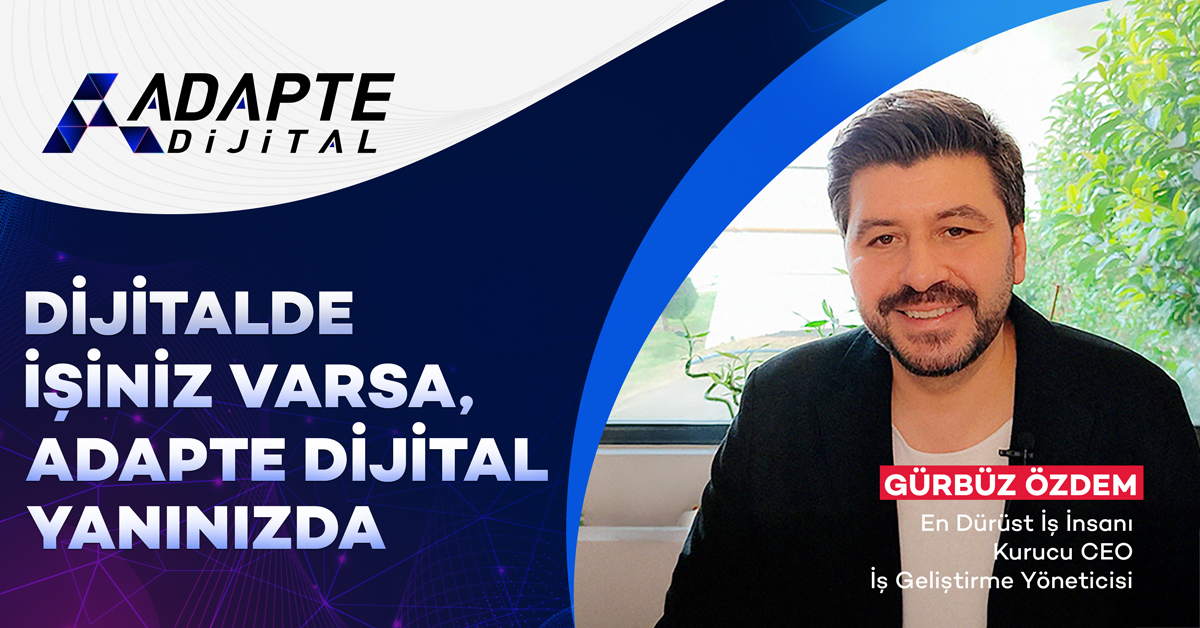MVP, or Minimum Viable Product, is the simplest form of a product that includes its most basic functions and can be offered to the market. It allows an idea or digital product to be tested before major investments are made. Especially in digital initiatives, the MVP approach offers an efficient roadmap in terms of both time and cost.
When developing a new digital product, implementing all the features at once carries a great risk. The product may not be popular when it is released or may not meet the real needs of the target audience. This is where MVP comes into play. A prototype is created with the most basic functionality and tested with real users. Thanks to the feedback collected during this process, the product direction becomes clear and unnecessary developments are avoided.
The MVP process is often carried out together with agile methodologies in the digital world. The product develops by learning from the user. This provides a product design that is both user-focused and sustainable. It is also an important indicator for investors; the idea is supported not only on paper, but also with a concrete user experience.

In short, MVP is the first but most critical step of digital product development. Using resources correctly is an indispensable strategy for knowing the market and understanding user expectations. A properly designed MVP is the first step to great success in the future.
İçindekiler
ToggleProduce the Right One, Not Everything
When a new business idea comes to mind, most entrepreneurs want to offer all the product features together. The most comprehensive, the best, the most different… However, this approach usually results in high costs, long loss of time and disappointment in the digital world. Because no matter how good your product is, acting without knowing how the market will react to it is like running in the dark.
Test the Least, Test the Most. The First Step to Digital Growth: MVP
Adapte Dijital’in 10 yıllık deneyimiyle geliştirilen bu model, kurumsal web sitenizi sadece tasarlamakla kalmaz;
onu data toplayan, talep yaratan, kurumsal iletişim sağlayan bir dijital yönetim altyapısına dönüştürür.
Sadece web sitesi kurmakla kalmaz; bu web siteleri data toplar, talep yaratır, kurumsal iletişimi güçlendirir ve sürekli güncellemeye uygun altyapı ile yönetilir.
This is where MVP, or Minimum Viable Product, comes into play. This concept is not only a product strategy for entrepreneurs of the digital age; it is also a way of thinking, a testing method, and a growth tactic. Building a business with an MVP approach eliminates unnecessary production risk, accelerates the learning process, and takes you on a product journey that is constantly evolving with feedback.
What is MVP?
MVP (Minimum Viable Product) is the simplest first version of a product that only contains the basic functions, but is sufficient for the target audience to experience and give feedback. The goal is to learn the real demands in the market, reduce risk and use resources efficiently.
Product Validation with MVP
Traditional business approach works with a “product first, then market” approach. MVP is the exact opposite: it first tests the market, then develops the product. It is based on the principle of presenting a product with its most basic features to the target audience, getting feedback, and shaping the product in light of this feedback. Thus, “will it sell?” The answer to the question comes before production.
Sample applications:
- Beta versions released with limited features
- Request verification by taking pre-orders
- Free demo or prototype presentations
- Measuring interest with “On the way” pages
- Version planning with feedback surveys

Why Develop an MVP?
The MVP development process takes product development from being just a technical process to a strategic learning tool. It allows testing product success at every step, not just when it is “done.” This makes the development process more accurate, faster, and more cost-effective. In addition, much more accurate positioning can be achieved with feedback from the market at an early stage.
Sample applications:
- Including user testing in the design phase
- Creating prototype-focused marketing pages
- Collecting user comments throughout the development process
- Analyzing first reactions with product introduction video
- Determining next features with data received after MVP
The Biggest Advantages of MVP
MVP provides the most data with the least amount of resources to understand if an idea works. Its biggest advantage is that it allows you to guide your product according to market reactions before investing blindly. In addition, the time and cost advantages of MVP strengthen the hand of small teams or individual entrepreneurs.
Sample applications:
Adapte Dijital’in 10 yıllık deneyimiyle geliştirdiği modellerle, kurumsal web sitenizi kurumunuzu/markanızı anlatan, tanıtan, güven yaratan, talep oluşturan bir dijital yönetim platformuna dönüştürür.
Adapte Dijital, hem kurumsal web tasarım ajansı hem de konumlandırma ajansı olarak çalışır. Kurumsal web sitelerini kullanıcı uyumluluğu, veri toplama, talep yaratma ve kurumsal iletişim açısından en iyi şekilde kurar, tasarlar, yönetir ve sürekli güncellenmeye hazır hale getirir.
- Make a pivot decision with user feedback after the MVP launch
- Measure audience compatibility by testing the MVP with advertising campaigns
- 80% of product development costs are made after launch
- Creating a product roadmap with referrals from users
- Gaining the opportunity to go to investors with data thanks to MVP
MVP’s Place in the Digital World
Time is very fast in the digital world, user expectations change instantly. MVP is not just a start in this world, it is the basis of the continuous learning and development process. Especially in digital products (application, software, platform), launching with MVP allows you to manage the development live and makes the user a partner in the process. This increases the sense of belonging and loyalty.
Sample applications:
- Releasing a SaaS application with a basic version
- Transition to beta release with only the main function in mobile applications
- Special testing process for the first 50 users on web-based platforms
- Rewarded feedback campaigns for users during the MVP process
- Establishing a feature request system after MVP
How to Plan the MVP Process?
MVP is not just a product, it is also a process. If not planned correctly, it may be perceived as an “incomplete product” or may not satisfy the user. Therefore, the purpose of the MVP, its target audience and what you want to learn should be clarified at the very beginning of the process. MVP is just the beginning of the product; therefore, it is important to remember that it is not the end of the process, but a tool for collecting data. In MVP planning, business goals and user expectations should be balanced; a structure that is not too complex but sufficiently functional should be designed. In addition, it should be clearly shared within the team that this process is for testing purposes. The more strategic the MVP process starts, the healthier the development will be.
Sample applications:
- Determining the basic KPIs that will measure the success of the MVP in advance
- Defining the 3 basic questions you want to learn from the user
- “Which feature is a must, which can wait?” structure plan with question
- Planning the test period and feedback channels
- Preparing scenarios (pivot, iteration, scale-up) after MVP
Which Tools Should Be Used?
The tools to be used in the MVP process save time, provide measurement, and strengthen communication. Choosing the right tools for tracking work, collecting user feedback, and prototyping, especially in small teams, makes a big difference. The tools need to be simple, flexible, and user-friendly. The tools to be used throughout the process generally focus on design, content, project management, CRM, and analysis. What is important here is not the number of tools, but how they are used. In the MVP development phase, integrating different tools and having a centralized working system increases efficiency.
Sample tools and usage scenarios:
- Figma: UI prototype design and interactive user tests
- Notion: MVP process documentation and work tracking
- Trello / Jira: Task tracking and sprint planning
- Typeform / Google Forms: Collecting user feedback
- Hotjar / Google Analytics: Analysis of visitor behavior

Post-MVP Product Development Methods
The end of the MVP process is the real beginning of the product journey. In line with the feedback collected, new features should be added, deficiencies should be eliminated, and the product should be reshaped according to the user’s requests. At this point, it is important to carry out product development not with the understanding that “the caravan is straightened out on the road” but with a systematic method. It is necessary to prioritize feedback, direct resources according to these priorities, and retest the process. The evolution of the product is not a fixed line; it is a flexible journey that changes with the users. This way, the product becomes stronger and closer to the user.
Sample methods:
- Scoring and prioritizing user feedback
- Making aggregate analysis with feature request board
- Making development decisions based on user-based scenarios
- Small iterations that fix bugs in the first version
- Re-validation with micro tests after each development
Closing: Start with Less, Improve with Data
The MVP approach means not only saving resources but also focus, flexibility and learning. While the traditional product development process involves great risks, with MVP these risks are reduced and opportunities become more visible. As an entrepreneur, you should see the MVP process as a “learning laboratory” rather than a “pre-launch”. Because this process directly affects the success of your product. Every comment, every form, every feedback brings you closer to a better solution.
In the Adaptive Business Model, the MVP process is the first building block of establishing and growing a business. It works in an integrated manner with demand collection, content testing, CRM usage and user interaction. Thus, your product does not just exist, it is in demand. Because in this approach, needs win, not the product.
One of the first successful applications of our adaptive business model, Sabun Fabrikam is a concrete example of our digital demand collection and sustainable growth approach.
Remember:
“It is not necessary to start with everything at first, finding the right thing early is success.”
👉 If you want to start the MVP process and grow your business based on data, contact us.






